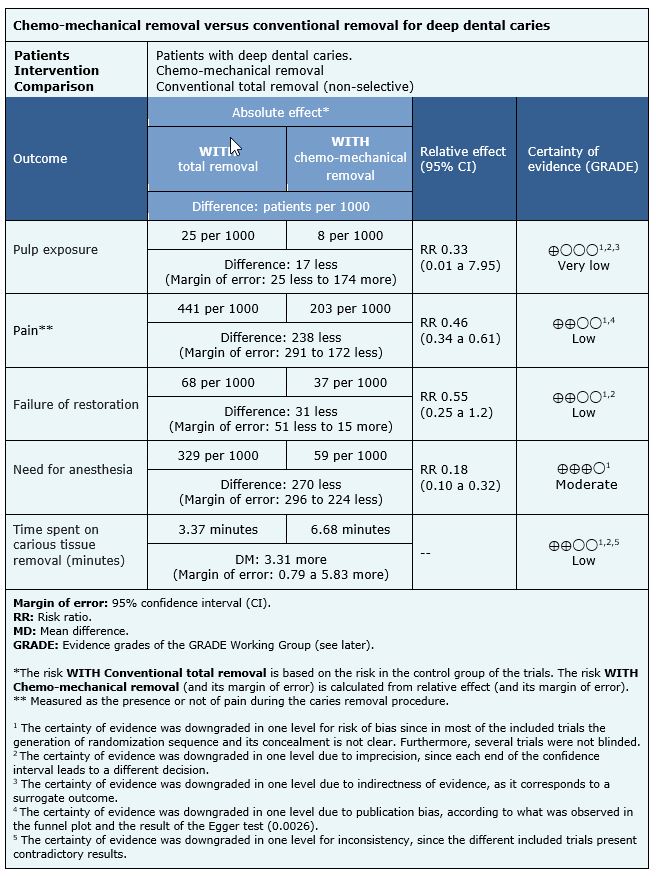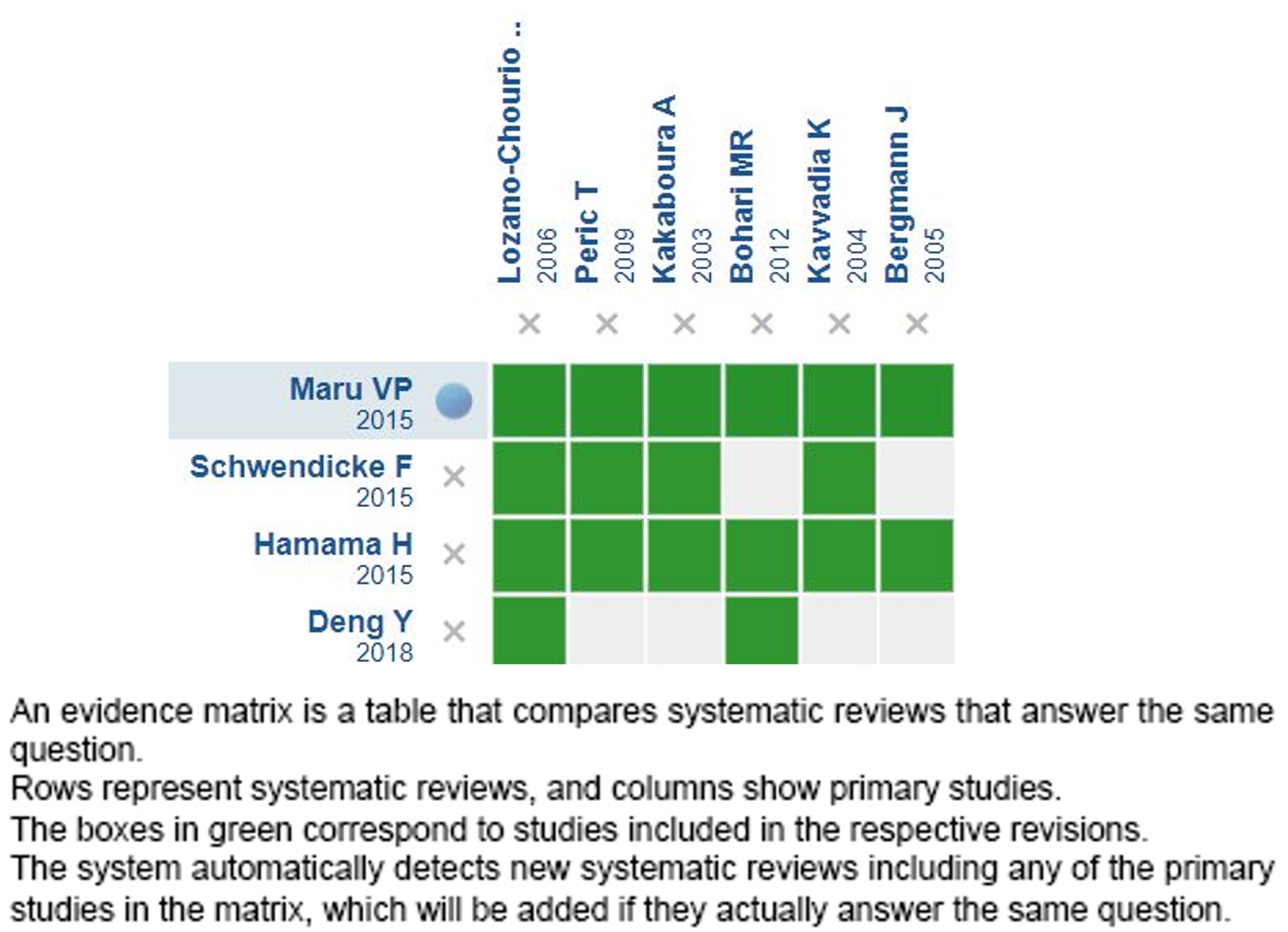Resúmenes Epistemonikos
← vista completaPublicado el 28 de enero de 2022 | http://doi.org/10.5867/medwave.2022.01.8320
Remoción química – mecánica comparada con remoción total convencional para lesiones de caries dentinarias profundas
Chemo-mechanical removal versus conventional removal for deep caries lesion
Abstract
INTRODUCTION Dental caries have been traditionally managed with the non-selective removal of carious tissue (total removal). However, the adverse effects and fear that this technique produces in patients has promoted the use of more conservative caries removal techniques such as chemo-mechanical removal, but there is still controversy regarding its effectiveness and safety.
METHODS We searched in Epistemonikos, the largest database of systematic reviews in health, which is maintained by screening multiple information sources, including MEDLINE, EMBASE, Cochrane, among others. We extracted data from the systematic reviews, reanalyzed data of primary studies, conducted a meta-analysis and generated a summary of findings tables using the GRADE approach.
RESULTS AND CONCLUSIONS We identified seven systematic reviews including 34 studies overall, of which 30 correspond to randomized trials. We concluded that chemo-mechanical caries removal probably reduces the need for anesthesia. Additionally, chemo-mechanical caries removal may decrease the pain experienced by the patient, decrease the risk of restoration failure and increase the time of the procedure for the removal of deep caries, but the certainty of the evidence is low. We are uncertain whether chemo-mechanical caries removal reduces the risk of pulp exposure as the certainty of the evidence has been assessed as very low.
Problem
Dental caries, the most prevalent oral condition worldwide [1], produces localized destruction of dental tissue [2]. The treatment of carious lesions consists of their removal and subsequent restorative treatment.
Currently there are several techniques for tooth decay removal. Conventional treatment involves the total (non-selective) removal of the caries with rotary and manual instruments. In recent years, the total removal technique has been criticized for increasing the risk of pulp exposure and pulp diseases [3], [4].
In addition, the conventional total removal technique causes anxiety and fear in patients. Consequently, new alternatives for caries removal have emerged such as chemo-mechanical removal [5], which allows the removal of carious tissue through the application of a substance that softens the affected tissue in combination with manual instrumentation [6]. The most reported products in the literature to carry out this technique are Carisolv (swedish origin) and Papacarie (brazil origin). Its mechanism of action is comparable and is based on the breakdown of partially degraded collagen molecules, which contributes to the degradation and elimination of the fibrin mantle formed by the carious process [7], [8]. However, it has been suggested that this technique would lead to restoration failure, so its use remains controversial [9]. This summary aims to evaluate the effectiveness and safety of chemo-mechanical removal compared to conventional total caries removal.
Methods
We searched in Epistemonikos, the largest database of systematic reviews in health, which is maintained by screening multiple information sources, including MEDLINE, EMBASE, Cochrane, among others, to identify systematic reviews and their included primary studies. We extracted data from the identified reviews and reanalyzed data from primary studies included in those reviews. With this information, we generated a structured summary denominated FRISBEE (Friendly Summary of Body of Evidence using Epistemonikos) using a pre-established format, which includes key messages, a summary of the body of evidence (presented as an evidence matrix in Epistemonikos), meta-analysis of the total of studies when it is possible, a summary of findings table following the GRADE approach and a table of other considerations for decision-making.
|
Key messages
|
About the body of evidence for this question
|
What is the evidence. |
We identified seven systematic reviews [9], [10], [11], [12], [13], [14], [15] including 34 primary studies reported in 35 references [16], [17], [18], [19], [20], [21], [22], [23], [24], [25], [26], [27], [28], [29], [30], [31], [32], [33], [34], [35], [36], [37], [38], [39], [40], [41], [42], [43], [44], [45], [46], [47], [48], [49], of which 30 were randomized trials [16], [17], [18], [19], [20], [21], [22], [23], [24], [25], [27], [28], [30], [31], [32], [33], [35], [36], [37], [38], [39], [40], [41], [42], [43], [45], [46], [47], [48, [49]. The table and summary are based on the randomized trials, as the observational studies did not increase the level of certainty of the evidence, nor added any additional relevant information. |
|
What types of patients were included* |
Of the 30 trials, 20 included only children (two to 12 years) [18], [19], [20], [21], [22], [23], [24], [27], [30], [31], [33], [35], [36], [37], [38], [40], [43], [46], [47], [49], four trials included children and adults (2.5 to 85 years) [16], [25], [28], [41], four trials included children, adolescents and adults (six to 68 years) [17], [39], [42], [48] and two trials did not report the age of the participants [32], [45]. Nineteen trials included only primary teeth [18], [19], [20], [21], [22], [23], [24], [27], [30], [31], [33], [36], [37], [38], [43], [45], [46], [47], [49], four trials included only permanent teeth [17], [39], [42], [48], four trials both dentitions [16], [25], [28], [41] and three trials did not report the type of dentition [32], [35], [40]. Finally, regarding the extent of the caries, all included only dentin caries, excluding those lesions limited only to enamel. [16], [17], [18], [19], [20], [21], [22], [23], [24], [25], [27], [28], [30], [31], [32], [33], [35], [36], [37], [38], [39], [40], [41], [42], [43], [45], [46], [47], [48]. |
|
What types of interventions were included* |
All trials compared chemo-mechanical removal against conventional treatment (total removal). Chemo-mechanical removal was described differently by the trials, but in general it was defined as the removal of cavities using chemicals that degrade carious tissue (Carisolv, Caridex, Carie-care or Papacarie) followed by the removal of the softened tissue with mechanical removal (spoon excavator) [9]. Fourteen trials used Carisolv [16], [17], [21], [24], [25], [27], [28], [30], [31], [41], [43], [45], [47], [48]. Seven trials used Papacarie [19], [20], [22], [23], [33], [40], [49]. Three studies compared Carisolv and Papacarie [18], [35], [46]. Four studies [36], [37], [38], [39] report using the Carie-care material. A single trial [32] used Caridex and only one trial [42] did not report what type of material was used. Total removal was described as excavation until pulpo-proximal dentine on the cavity floor was hard on probing [9]. |
|
What types of outcomes |
The trials evaluated multiple outcomes, which were grouped by the systematic reviews as follows:
These trials reported [22,33,24,25,33,47] follow-up that ranged from 1 to 18 months; the other studies did not report the follow-up time. |
* Information about primary studies is not extracted directly from primary studies but from identified systematic reviews, unless otherwise stated.
Summary of findings
The information on the effects of chemo-mechanical caries removal is based on 30 randomized trials that included 1,351 patients [16], [17], [18], [19], [20], [21], [22], [23], [24], [25], [27], [28], [30], [31], [32], [33], [35], [36], [37], [38], [39], [40], [41], [42], [43], [45], [46], [47], [48].Only one trial measured pulp exposure events (40 patients, 80 teeth) [30], 10 trials measured pain (553 patients and 839 teeth) [16], [20], [22], [24], [25], [28], [31], [38], [47], [48], six trials evaluated restoration failure events (261 patients, 432 teeth) [21], [22], [24], [25], [31], [47], 14 trials measured the need for anesthesia (703 patients and 1169 teeth) [16], [17], [21], [23], [24], [25], [28], [30], [31], [32], [33], [39], [47], [48] and 24 trials measured time spent on carious tissue removal (1163 patients and 2069 teeth) [16], [17], [18], [19], [20], [21], [22], [23], [24], [25], [27], [28], [30], [31], [32], [33], [35], [36], [37], [38], [39], [46], [47], [48].
The summary of findings is as follows:
- We are uncertain whether chemo-mechanical caries removal reduces the risk of pulp exposure as the certainty of the evidence has been assessed as very low.
- Chemo-mechanical caries removal compared to total removal may decrease the risk of pain during caries removal procedure (low certainty of evidence).
- Chemo-mechanical caries removal compared to conventional total removal may decrease the risk of failure of restorations (low certainty of evidence).
- Chemo-mechanical caries removal compared to conventional total removal probably reduces the need for anesthesia (moderate certainty evidence).
- Chemo-mechanical caries removal compared to conventional total removal could increase the time of the procedure (low certainty of the evidence).

| Follow the link to access the interactive version of this table (Interactive Summary of Findings – iSoF) |

Other considerations for decision-making
|
To whom this evidence does and does not apply |
|
| About the outcomes included in this summary |
|
| Balance between benefits and risks, and certainty of the evidence |
|
| Resource considerations |
|
| What would patients and their doctors think about this intervention |
|
|
Differences between this summary and other sources |
|
| Could this evidence change in the future? |
|
How we conducted this summary
Using automated and collaborative means, we compiled all the relevant evidence for the question of interest and we present it as a matrix of evidence.

Follow the link to access the interactive version: Chemo-mechanical removal versus conventional removal for deep dental caries
Notes
The upper portion of the matrix of evidence will display a warning of “new evidence” if new systematic reviews are published after the publication of this summary. Even though the project considers the periodical update of these summaries, users are invited to comment in Medwave or to contact the authors through email if they find new evidence and the summary should be updated earlier.
After creating an account in Epistemonikos, users will be able to save the matrixes and to receive automated notifications any time new evidence potentially relevant for the question appears.
This article is part of the Epistemonikos Evidence Synthesis project. It is elaborated with a pre-established methodology, following rigorous methodological standards and internal peer review process. Each of these articles corresponds to a summary, denominated FRISBEE (Friendly Summary of Body of Evidence using Epistemonikos), whose main objective is to synthesize the body of evidence for a specific question, with a friendly format to clinical professionals. Its main resources are based on the evidence matrix of Epistemonikos and analysis of results using GRADE methodology. Further details of the methods for developing this FRISBEE are described here (http://dx.doi.org/10.5867/medwave.2014.06.5997)
Epistemonikos foundation is a non-for-profit organization aiming to bring information closer to health decision-makers with technology. Its main development is Epistemonikos database (www.epistemonikos.org).
Potential conflicts of interest
The authors do not have relevant interests to declare.

